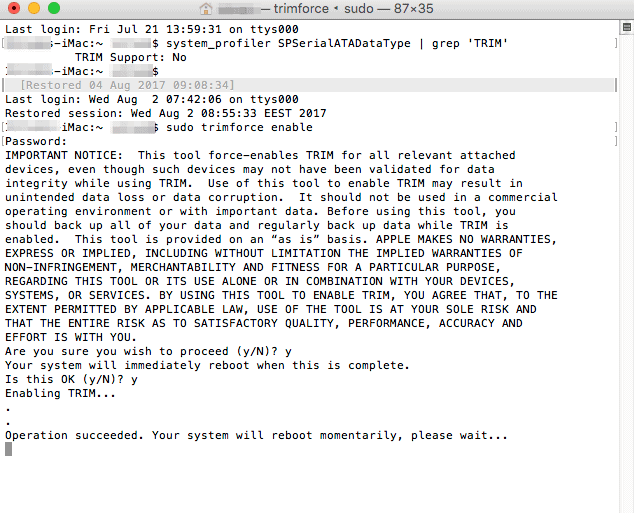Windows 7 and above are set to automatically enable TRIM on solid-state drives. You shouldn’t need to worry about enabling TRIM yourself. But, if you want to double-check that Windows has enabled TRIM, you can.
Jul 21, 2017 I have 'Disk Sensei by Cindori.org'. I am running Mac OS Sierra 10.12.1 2014 MBP with an apple SSD. What I have noticed and mentioned to Apple tech support is that they no longer show 'trim support' for your SSD ( I am sure this is an oversight in the OS ). This is a problem if you have an SSD. How to Enable TRIM. Windows should automatically enable TRIM if you have a modern version of Windows with a modern solid-state drive. If TRIM is disabled, it’s possible that Windows knows something you don’t, and TRIM shouldn’t be enabled for a drive. Perhaps it’s a a very old solid-state drive.

When TRIM is enabled, Windows will send an instruction to your solid-state drive every time you delete a file. The solid-state drive can then automatically erase that file’s contents. This is important for maintaining speedy solid-state drive performance.
How to Check if TRIM Is Enabled
You’ll need to check this from an Administrator Command Prompt window. To open an Administrator Command Prompt window on Windows 10 or 8.1, right-click the Start button and select “Command Prompt (Admin).”
On Windows 7, open the Start menu, search for “Command Prompt”, right-click the “Command Prompt” shortcut, and select “Run as Administrator.”
Run the following command in the Command Prompt window:
You’ll see one of two results. If you see DisableDeleteNotify = 0 , TRIM is enabled. Everything is good and you don’t need to worry about it. (This is a little confusing at first glance—with a value of 0, the DisableDeleteNotify option is disabled. That’s a double negative, which means “DeleteNotify,” also known as TRIM, is enabled.)
If you see DisableDeleteNotify = 1 , TRIM is disabled. This is a problem if you have an SSD.
How to Enable TRIM
Macos Enable Trim Ssd
Windows should automatically enable TRIM if you have a modern version of Windows with a modern solid-state drive. If TRIM is disabled, it’s possible that Windows knows something you don’t, and TRIM shouldn’t be enabled for a drive. Perhaps it’s a a very old solid-state drive. However, it’s also possible that TRIM really should be enabled but something messed up in the automatic detection process.
If TRIM isn’t enabled and you’d like to enable it, you can forcibly do so by running the following command in an Administrator Command Prompt window:
(If you’d like to disable TRIM afterwards for some reason, run the above command with a 1 in place of the 0 .)
How to Check if Windows Is Running Retrim on a Schedule
RELATED:Don’t Waste Time Optimizing Your SSD, Windows Knows What Its Doing
On Windows 8 and 10, Windows automatically optimizes solid-state drives on a schedule by running the “retrim” operation. This is necessary because, if many TRIM requests are sent to a drive at once, the requests may build up in a queue and then be discarded. Windows regularly performs “retrim” optimizations that ensure all the TRIM requests sent to a drive are in fact processed. You can read more about this on Microsoft employee Scott Hanselman’s blog.
The “retrim” feature is only included in Windows 8 and 10, so Windows 7 users don’t need to worry about this.
Enable Trim Ssd Mac Mojave
To check that Windows is performing retrim optimizations on a schedule, open the Optimize Drives application. Open the Start menu, search for “Optimize Drives”, and click the “Defragment and Optimize Drives” shortcut.
Click the “Change Settings” button and ensure “Run on a Schedule (Recommended)” is enabled. By default, Windows will run the retrim optimization on a weekly schedule.
Again, this isn’t something you should need to worry about. If your computer has an SSD, Windows should automatically enable TRIM and enable optimizing the drive with retrim on a schedule. These options should just be enabled by default. But it’s worth giving a quick look to make sure everything’s running properly.
READ NEXT- › A New Wireless Standard: What Is Amazon Sidewalk?
- › How to Use Text Editing Gestures on Your iPhone and iPad
- › Windows 10’s BitLocker Encryption No Longer Trusts Your SSD
- › How to Disable or Enable Tap to Click on a PC’s Touchpad
- › How HTTP/3 and QUIC Will Speed Up Your Web Browsing